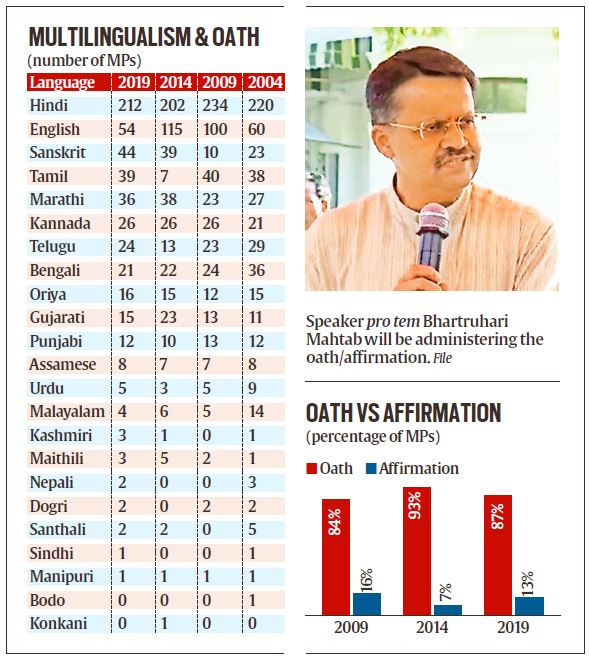Context
-
The first session of the 18th Lok Sabha will start on Monday. Before the House can begin its legislative functioning, the newly elected members will have to take the oath of Members of Parliament (MP), which is provided in the Constitution.
-
The President shall entrust the duties of the Speaker (pro tem) under Article 95(1) of the Constitution till the election of the new Speaker.
-
When does the term of an MP begin?
- The five-year term of a Lok Sabha MP begins when the Election Commission of India (ECI) declares the results according to Section 73 of the Representation of the People Act, 1951.

Pic Source: The Indian Express - From that day onward, MPs are eligible for certain rights as elected representatives. For example, they start receiving their salary and allowances from the date of ECI notification — after the 2024 general elections, the ECI declared results on June 6.
- The start of their term also means that if MPs change their party allegiance, their political party can ask the Speaker to disqualify them from Parliament under the anti-defection law.
Parliamentary oath
- The Constitution’s third schedule contains the text of the parliamentary oath.
- Winning the election and starting the term does not automatically allow an MP to participate in House proceedings.
- Article 99: To debate and vote in Lok Sabha, an MP has to take her seat in the House by making and subscribing to an oath or affirmation prescribed in the Constitution.
- Article 104: The Constitution also specifies a financial penalty (the only one in the document) of Rs 500 if a person participates or votes in House proceedings without taking an oath.
- However, there is an exception to this rule. An individual can become a minister without being elected to Parliament. They have six months to secure a seat in either Lok Sabha or Rajya Sabha. During this time, they can participate but not vote in House proceedings.
How has the oath evolved over years?
- The draft Constitution prepared by the drafting committee, chaired by Dr B R Ambedkar, did not invoke God in any oaths. The committee stated that the person taking the oath solemnly and sincerely promises to bear true faith and allegiance to the Constitution.
- Dr B R Ambedkar accepted the amendments that the oath in the name of God provides the sanction which is necessary for the fulfilment of obligations which are purely moral and for which there is no sanction provided.
- The last change in the oath was the Constitution (Sixteenth Amendment) Act, 1963, which added that the oath-takers would uphold India’s sovereignty and integrity. The amendment was made on the recommendations of the National Integration Council.
How do MPs take the oath?
- Before being called upon to take the oath or affirmation, MPs must submit their election certificate to the Lok Sabha staff.
- Parliament added this safeguard after an incident in 1957, in which a mentally unsound individual posed as an MP and took the oath on the floor of the House.
- After the verification, MPs can subscribe to the oath or affirmation in English or any of the 22 languages specified in the Constitution.
- Roughly half the MPs take their oath in Hindi or English.
- MPs must use the name mentioned in their election certificate and adhere to the text of the oath.
- Oaths and affirmations are a matter of personal choice for MPs.
- MPs have sometimes sworn in the name of God in one term and affirmed in another.
Can MPs in jail take the oath?
- The Constitution specifies that if an MP does not attend Parliament for 60 days, their seat can be declared vacant.
- Courts have used this ground to allow MPs in jail to take an oath in Parliament.
Source: IE
Visit Abhiyan PEDIA (One of the Most Followed / Recommended) for UPSC Revisions: Click Here
IAS Abhiyan is now on Telegram: Click on the Below link to Join our Channels to stay Updated
IAS Abhiyan Official: Click Here to Join
For UPSC Mains Value Edition (Facts, Quotes, Best Practices, Case Studies): Click Here to Join
